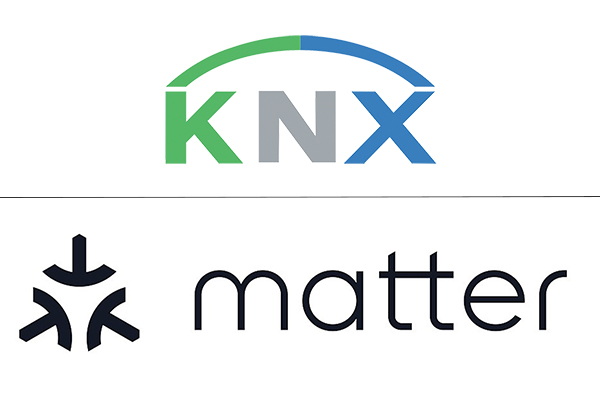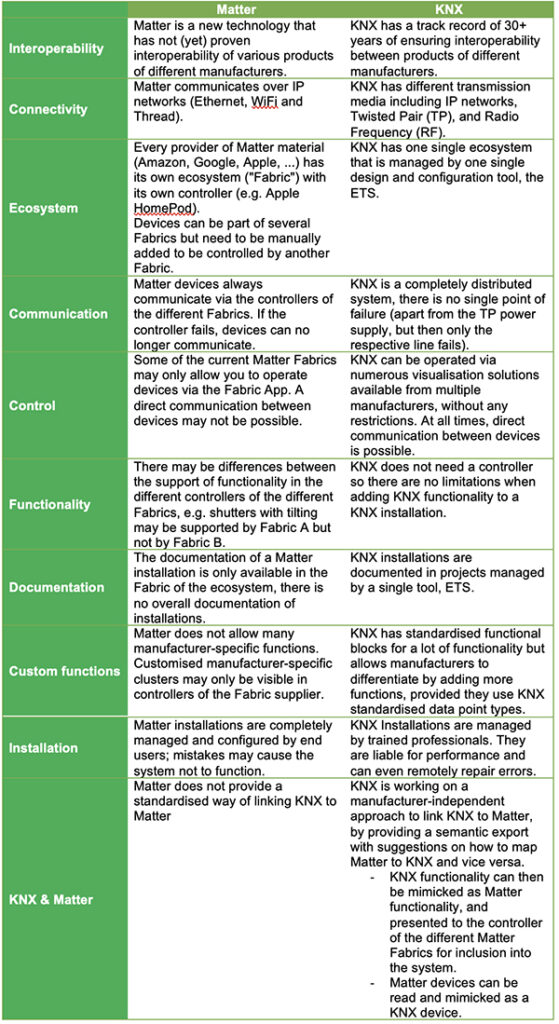

Joost Demarest and Casto Cañavate provide a high-level comparison of KNX and Matter, discuss how the two technologies can work together, and show why a KNX ecosystem is still the logical choice over the long term.
Anything that helps with the democratisation of smart home technology is a welcome move. For thirty plus years, KNX has been unique in offering a worldwide standard that ensures products from competing companies can work together seamlessly, reliably, and over the long term.
The official launch of Matter, an open-source connectivity standard for smart home and IoT devices, developed by Amazon, Apple and Google, amongst others, in late 2022, has rightly generated a lot of interest. Whilst Matter is geared towards a key principle of KNX; namely interoperability between products from competing companies, there are notable differences.
In this article we provide a high-level direct comparison, a quick comparison chart and our view on the position and market segmentation of KNX and Matter.

HIGH LEVEL DIRECT COMPARISON
Smart homes – Standards and Technologies
KNX
• A smart home standard that fixes the rules, protocols, and specifications that define how different smart devices communicate with each other.
• Functions as the backbone of any fully-integrated smart home by ensuring interoperability, security, and operation within an ecosystem.
• KNX products comply to ISO/IEC & EN standards. Therefore, smart home devices from various manufacturers can work together cohesively, offering a better user experience and enabling a more comprehensive smart home environment.
Matter
• A technology that has been accepted by the members of Connectivity Standards Alliance (CSA). The technology of Matter itself is not an international (EN or ISO) standard.
• Every manufacturer can use Matter technology and add additional features in the products from their brands. In this way, manufacturers of devices can offer additional functionalities if the end-customer uses products from the same brand.
Different organisations, different approaches
KNX
• Founded in the ’90s, benefitting from unparalleled expertise and longevity.
• Pioneers in the field of home and building automation who defined the first international standard for smart homes, meaning homeowners were no longer tied to a single brand or manufacturer.
• International recognition, a massive professional community consisting of 500+ manufacturers and 125,000+ systems integrators, guaranteeing lifelong support for homeowners.
• Expanded expertise over time, started out as a bus system (wired technology), it now offers wireless solutions with KNX RF, as well as wired or wireless solutions over IP (IPv4 and IPv6).
Matter
• A collaborative project of members of the CSA that has been on the market since 2020.
• The technology has gained much attention and traction in a short time, mostly due to the participation of big tech companies (including Google, Amazon and Apple).
• Expertise lies in wireless communication technologies.
Integration options
KNX
• The standard supports scaling of smart homes, integrating any number of smart devices of different brands.
• It offers full integration of 8000+ certified devices from 500+ KNX Members.
• All KNX products require only one commissioning tool (ETS) in order to be configured, meaning homeowners can mix different brands that suit their homes best, without any limitations.
Matter
• A good option to experiment with a certain brand or smart system.
• When users want to add more devices and systems to their setups, they may experience limitations, as Matter allows only partial connectivity between devices from different brands.
Assessing interoperability
KNX
• Has always been a champion of full interoperability for smart homes, meaning that different devices and brands can interact and integrate seamlessly with one another within the same ecosystem. This fosters interoperability and flexibility in choosing devices for a KNX installation.
Matter
• As a collaboration between some of the largest tech companies, there may be a reluctance to allow the sharing of information between different existing ecosystems.
• It will be possible to link your smart hub with smart lights purchased from a Matter device provider and turn lights on and off for example. To change settings or set up automations though, you will likely need to use the App corresponding to the selected smart hub.
Installation processes
KNX
• Homeowners can rely on the full support and knowledge of an automation professional to guide the installation process.
• Homeowners can share their expectations for a smart home with an expert, after which all necessary devices and auxiliary equipment will be purchased for them. This may sound more expensive in the short term, but it results in more features being exploited and peace of mind because of the fully integrated, professionally-secured setup that will continue to work over the long term.
Matter
• Offers a DIY solution for products that can easily be bought online at an affordable price.
• The technical setup is limited because all device communications run through Wi-Fi, Bluetooth and other well-known wireless options where devices first need to be connected to the network, after which they can be onboarded to the ecosystem. Devices also have to be paired to each other before they’re ready to use.
Scalability
KNX
• Offers scalability to meet the needs of the smallest home through to the largest commercial building, with any level of automation, and can be adapted as requirements change over time.
• Scaling a smart home project with KNX technology is easy and fast, thanks to the commissioning tool, ETS. With ETS, the complexity of changing or enlarging the installation is significantly reduced, enabling professionals to effortlessly expand systems.
Matter
• Scalability may have limitations as the network expands. As more devices are connected into a Matter-enabled ecosystem, the complexity of managing and configuring these devices can become a significant challenge for users.
• Due to the lack of a common commissioning tool, the inherent challenge of scalability lies not just in the physical addition of new devices and managing updates, but also in ensuring seamless interoperability and maintaining a user-friendly experience.
Security and Privacy
KNX
• KNX safeguards communication and data integrity with state-of-the-art security features. With encryption and authentication, in addition to initiatives such as the KNX Secure Checklist, KNX aligns with all relevant cybersecurity regulations and is suitable for applications with privacy and security requirements.
• In addition to communication and data protection, KNX technology protects the devices themselves (Device Configuration Password) and the ETS project (ETS project password).
Matter
• With features including end-to-end encryption to protect user data and ensure secure communication between devices, Matter has a clear focus on security and privacy.
Physical Media
KNX
• KNX’s flexible physical media supports a diverse range of installations: Twisted-Pair wiring (KNX TP), Radio Frequency (KNX RF) and over IP (KNXnetIP for IPv4 as well as KNX IoT for IPv6) including Ethernet, Wi-Fi, and Thread.
Matter
• Matter’s IP-based protocol work supports connectivity technologies that include Ethernet, Wi-Fi, and Thread.
QUICK COMPARISON GUIDE

POSITIONING AND SEGMENTATION
KNX ecosystem, extended with Matter devices
The unique potential of KNX lies in its ability to fully integrate smart devices and applications within ONE secure ecosystem, a potential that can be expanded by incorporating new technologies, such as Matter, into the KNX ecosystem:
• KNX is the essential backbone of the smart home, offering a reliable, secure, and fully-functional system. The KNX system integrates and controls a wide range of device types, including heating, blinds, lighting, wall switches, sensors (such as motion, temperature, brightness, etc) and many more.
• Matter can serve to extend a KNX smart home with additional consumer devices, such as TVs, streaming devices, white goods, smart lamps, bulbs, smart sockets, etc.
The home automation journey – An opportunity for KNX!
Homeowners’ choices will depend on where they are in their automation journey. Those just starting to explore smart devices, will find that Matter is a good option for making simple connections at an entry level. If they become overwhelmed and unable to extend their Matter system, they are likely to be ready for a more (or fully) integrated setup that KNX offers.
In summary:
• KNX guarantees that smart devices and applications can communicate and work seamlessly with each other.
• Homeowners can integrate an unlimited number of products into one ecosystem with professional support, without needing to commit to one brand.
• KNX enables limitless scalability and adaptability of the system as requirements change and new devices or features come to market.
Joost Demarest and Casto Cañavate are the KNX Association CTO/CFO and Marketing Manager respectively.












